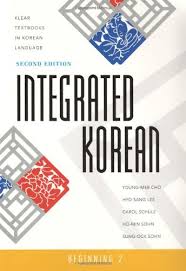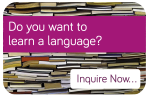People interested in beginning to learn Korean often come to
me and ask what book I think is best for those with no experience in the language. This is a difficult question to answer because there are so many great Korean textbooks to choose from, that it can be hard to pick out just one to recommend over all the others. When it comes down to it, however, I think there is one series of Korean texts that manages to stand out among its competitors – the Integrated Korean series put out by University of Hawai'i Press.
Starting with the introduction, one can see that Integrated Korean does not take any shortcuts. The authors have put together one of the best introductions I have found in any language textbook, giving students a thorough review of the relevant background and features of the Korean language, along with lessons on pronunciation, writing, and some useful classroom expressions. The only potential fault I see in this beginning section is that some students might find the amount of details presented to be a little overwhelming. While I (as a linguist) personally appreciate the level of depth given in their explanations of the Korean sound system, there is a lot of linguistic jargon used that might have the effect of making things sound more complicated than they actually are. This doesn't make the section on pronunciation useless, it just means that students and teachers will have to make an extra effort to ensure there is a full understanding how Korean phonology works.
The main content of the course is made up of sixteen lessons (through two books) which all follow the same basic structure:
· Two conversations
· One narration based upon the content of the conversations
· Vocabulary
· Pronunciation
· Notes on new words and expressions
· Culture
· Grammar with exercises
· Classroom exercises
· English translation of the conversations/narration
I really like the fact that every lesson in this course adheres to this same format, because it allows the students to get into a rhythm and develop consistent strategies for working through the texts. Also, it keeps the focus on communication by starting each lesson with conversations, while also giving ample attention to all the other areas that need to be addressed. Having the English translation at the end of each lesson (greatly separated from the conversations) is a great feature, because it provides a reference if anything is unclear to the students after studying the vocabulary and grammar, without making them as tempted to use the translation as a crutch. At the end of both texts there are the standard appendices, glossaries, and a grammar index. There isn't really anything special to mention as far as those sections go, aside from that the grammar index shows all the grammar taught in the book in alphabetical order, with references to its first appearance in the text and where to find the explanation for it, which is pretty convenient. There are supplementary workbooks that can optionally be used with these textbooks, containing many more exercises to give students extra practice.

The conversations in this book are very useful, sound natural, and can be listened to with audio files available for free from the publisher's website. Students may find the audio recordings a little bit difficult at first, as the voice actors speak at a normal rate (not slowed down for beginners), but this extra challenge will ultimately serve to benefit them. I am a huge fan of the themes covered in the conversations, as they focus on communicative situations that new learners of Korean are likely to have (or desire to be able to have), instead of the typical touristy content that plagues many introductory texts. One potential disadvantage of the course is that university students are the target audience, which may put off adult learners desire conversations more relevant to their life situation. Personally, I believe that the content of the lessons is relevant regardless of whether or not one is a university student, and a little tweaking or augmentation of the vocabulary should be all that is needed to accommodate learners of any background. The narration following the conversations is a great tool to recap and review the content of the conversations. I think it's a great addition that allows students to learn from the beginning not only how to talk about themselves (from the conversations), but also how to talk about others and how to tell stories.
A large vocabulary list follows the conversations and narration, organized alphabetically by part of speech, with a smaller section listing vocabulary thematically. It has been proven that most students retain vocabulary better when it is presented in themes, so it's great that students are given the opportunity to review vocabulary this way. My only problem with the vocabulary sections in this course is that the way words are organized can sometimes make it hard for students to find what they're looking for. When encountering a new word, especially for beginning students, it often may not be clear what part of speech the given word belongs to. This means that they may have to hunt through several lists before finding the definition for a word. Also, even if students can readily identify the part of speech, they will still have to scan through different sections, flipping back and forth, if they want to reference vocabulary as they are reviewing the conversations. It's not too huge of an inconvenience, and I have certainly seen worse vocabulary lists in other textbooks, but students or teachers may find it useful to create their own vocabulary lists to make learning go a bit more smoothly.
One unique perk featured in this book is a little box at the end of each vocabulary section showing how to properly pronounce words that are likely to be mispronounced by students. It shows the pronunciation of these words both in careful and casual speech, which is greatly useful for students who will probably be expected to produce the former, while often being exposed to the latter. While the primary purpose of this section is for clarification, it's also great for helping students remember that pronunciation is an ever-present issue, something they can always improve upon.
"Each lesson presents a new aspect of Korean culture to the student that is educational as well as interesting. There are also pictures of Koreans and Korea included that help bring life to the text and provide a context for the communication students are learning."
Another thing these books do great is the attention they give to teaching the students culture. Each lesson presents a new aspect of Korean culture to the student that is educational as well as interesting. There are also pictures of Koreans and Korea included that help bring life to the text and provide a context for the communication students are learning.
Grammar is taught through examples, a brief explanation, and exercises. Unlike most texts, which separate the grammar section from the exercises, this course follows up each grammar point with an exercise that will immediately ask students to put what they have learned into use. I think this is a great feature, as it can help with retention of the grammar's function, while simultaneously letting students “make it their own” so that they can start to use it to express themselves. There is no key in the book for students to check their answers against, but many of the exercises are so straightforward that students will not find correction necessary.
Overall, I would say that this is a first-class language course – a standout not only from other Korean textbooks, but among language books in general. What this means for Korean teachers is that you will be doing yourself and your students a huge favor by choosing this as your primary text for class. For students, this means that you can be confident that this is probably the best tool you can find for ensuring your success in acquiring the Korean language. In addition to these beginning level textbooks, the series also includes intermediate, upper-intermediate, advanced, and high advanced books that make it easier to continually advance their level of proficiency. This is a huge advantage to learners, who are often wondering what the next step is on their learning path. I highly recommend these books to all teachers and students of Korean.



